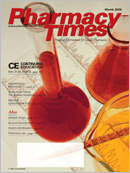Publication
Article
Pharmacy Times
Disaster: Failing to Consider the Time Course
Several years ago, a 75-year-old manwho was stabilized on warfarin for atrialfibrillation was started on fluconazole800 mg daily for 1 week, then 400mg daily for 3 weeks.1 Two days laterhe was discharged from the hospital,and the physicians—who knew aboutthe drug interaction between warfarinand fluconazole—told the patient tohave his international normalized ratio(INR) checked 1 week after discharge.They apparently were unaware that asubstantial increase in warfarin effectcould occur after a few days on fluconazole.
One week after finishing the fluconazole,the patient came back to theemergency department with backpain; his INR was now 40. He subsequentlydeveloped severe leg weaknessas well as bladder and bowelincontinence. Magnetic resonanceimaging showed an epidural hematoma,which resulted in a prolongedhospital stay with extensive physicaltherapy. At discharge, he could notwalk without assistance, and herequired catheterization for his neurogenicbladder.
What Can Be Learned from ThisCase?
The primary lesson is that simplyknowing that a patient is taking interactingdrugs is not sufficient to preventserious adverse outcomes. If the interactingdrug combination is deemed necessary,as it was in this case, one mustbe prepared to manage the interactionto minimize the risk of an adverseevent. Effective management usuallyincludes assessment of the likely timecourse of the drug interaction, so thatthe patient can be monitored at theappropriate times.
When a CYP2C9 inhibitor such as fluconazoleis given to a patient who isstabilized on warfarin—which has along half-life—the INR usually increasesgradually over 7 to 10 days.2 This situationdoes not mean, however, thatone can wait 7 to 10 days to monitorthe INR, because an excessive INR canoccur in just a few days, thus puttingthe patient at risk.
Of course, the patient's INR at the timethe fluconazole is started also can beimportant. For example, if the patient isunderdosed with warfarin and has a subtherapeuticINR, he or she could actuallybenefit from the fluconazole. On theother hand, if the patient has a borderlinehigh INR prior to starting the fluconazole,he or she may become overanticoagulatedmore rapidly and to a greater extentthan one might expect.
How Can One Predict the TimeCourse of Drug Interactions?
Look at the Literature
For many drug interactions, there areenough case reports and pharmacokineticstudies to predict the likely timecourse of drug interactions. It is known,for example, that giving a CYP3A4inhibitor such as verapamil to a patienton carbamazepine usually results in clinicalcarbamazepine toxicity within a fewdays. On the other hand, a patient stabilizedon lithium who starts taking anangiotensin-converting enzyme inhibitoroften develops lithium toxicity onlyweeks later.
Use Pharmacokinetic Principles
If the literature does not have adequateinformation on time course, onecan sometimes estimate the timecourse using simple pharmacokineticprinciples. We will assume that oneknows that theophylline has a half-life ofabout 8 hours in adult nonsmokers, anda particular CYP1A2 inhibitor approximatelydoubles the theophylline half-life.Because it takes about 4 half-lives toachieve steady state, multiplying thenew prolonged half-life of 16 hourstimes 4 gives a new steady state atabout 2 to 3 days.
Consider the Mechanism of theInteraction
Knowing the mechanism of the interactioncan provide important insightsinto the time course.
Gastrointestinal absorption. If onedrug binds with another in the gastrointestinaltract, it is just like decreasing thedose of the affected (object) drug. Thus,reduced therapeutic effect can be seenfairly quickly, especially if the absorptionof the object drug is markedly affected.
Enzyme induction. Increased objectdrug metabolism due to enzyme inductiontends to be fairly gradual and cantake up to a week or more for maximaleffect.
Enzyme inhibition. As already mentioned,the time course of enzyme inhibitionreactions depends largely on thehalf-life of the object drug, althoughother factors also can be involved.
Pharmacodynamic interactions. Dependingon the type of pharmacodynamicinteraction, the effects can beobserved almost instantly, or they maytake many weeks.
Drs. Horn and Hansten are both professorsof pharmacy at the Universityof Washington School of Pharmacy.For an electronic version of this article,including references if any, visitwww.hanstenandhorn.com.
For a list of references, send astamped, self-addressed envelope to:References Department, Attn. A. Stahl,Pharmacy Times, 241 Forsgate Drive,Jamesburg, NJ 08831; or send an e-mailrequest to: [email protected].







